Report: Communicating in Health and Social Care - [University]
VerifiedAdded on 2023/01/10
|9
|2692
|43
Report
AI Summary
This report delves into the crucial role of communication within the health and social care sector. It begins by examining two key theoretical approaches: the humanistic and psychoanalytic theories, highlighting their impact on practitioner-patient relationships and the understanding of patient behavior. The report then evaluates various communication methods, including formal, informal, verbal, non-verbal, and written forms, emphasizing their effectiveness in different healthcare scenarios. A significant portion is dedicated to analyzing communication barriers, such as language, environmental, and emotional challenges, and proposes strategies for overcoming them. Furthermore, the report identifies alternative communication methods, particularly for individuals with special requirements, and underscores the importance of confidentiality, linking it to the Caldicott principles. Finally, the report assesses the benefits of Information and Communication Technology (ICT) for both service users and practitioners, while also addressing the Data Protection Act and its application in health and social care settings.
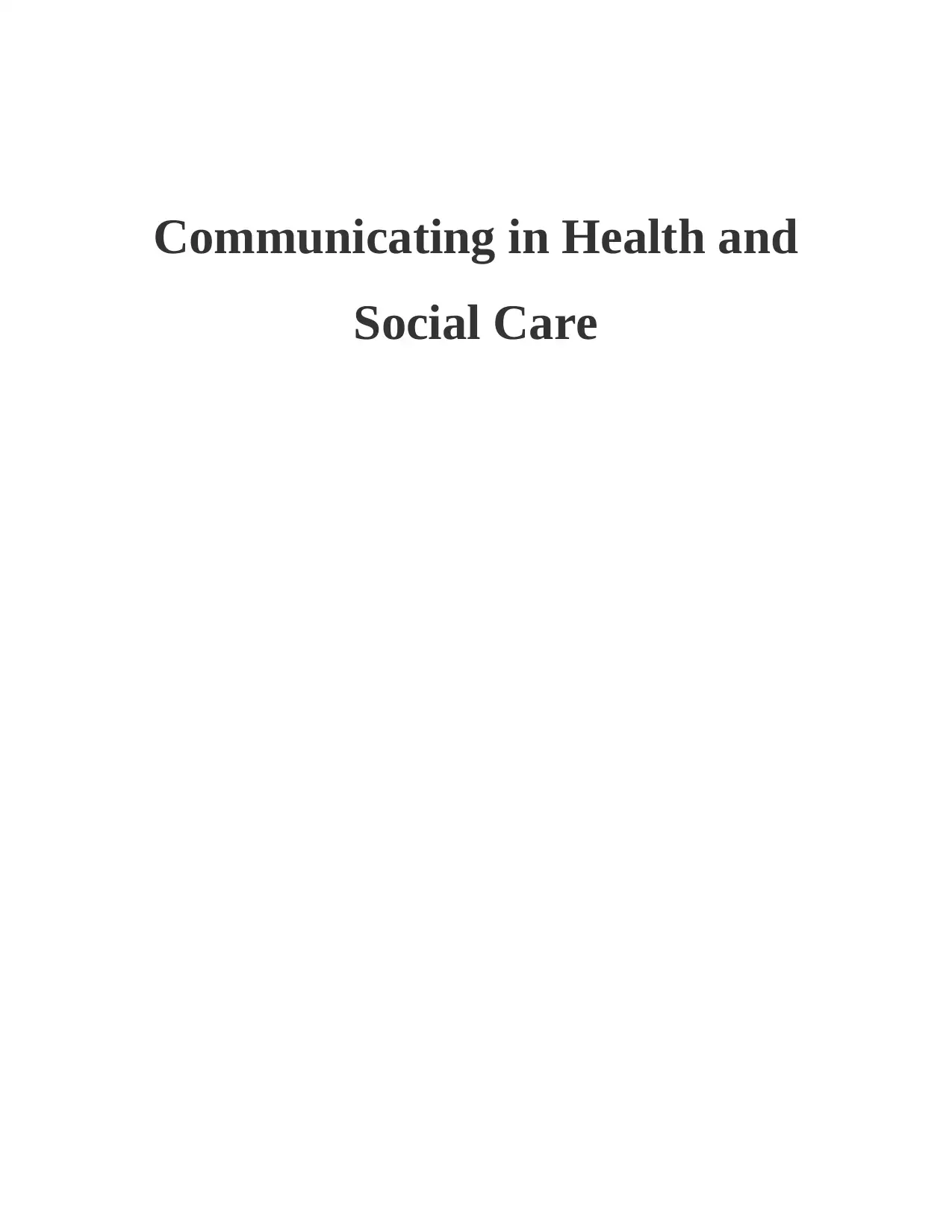
Communicating in Health and
Social Care
Social Care
Paraphrase This Document
Need a fresh take? Get an instant paraphrase of this document with our AI Paraphraser
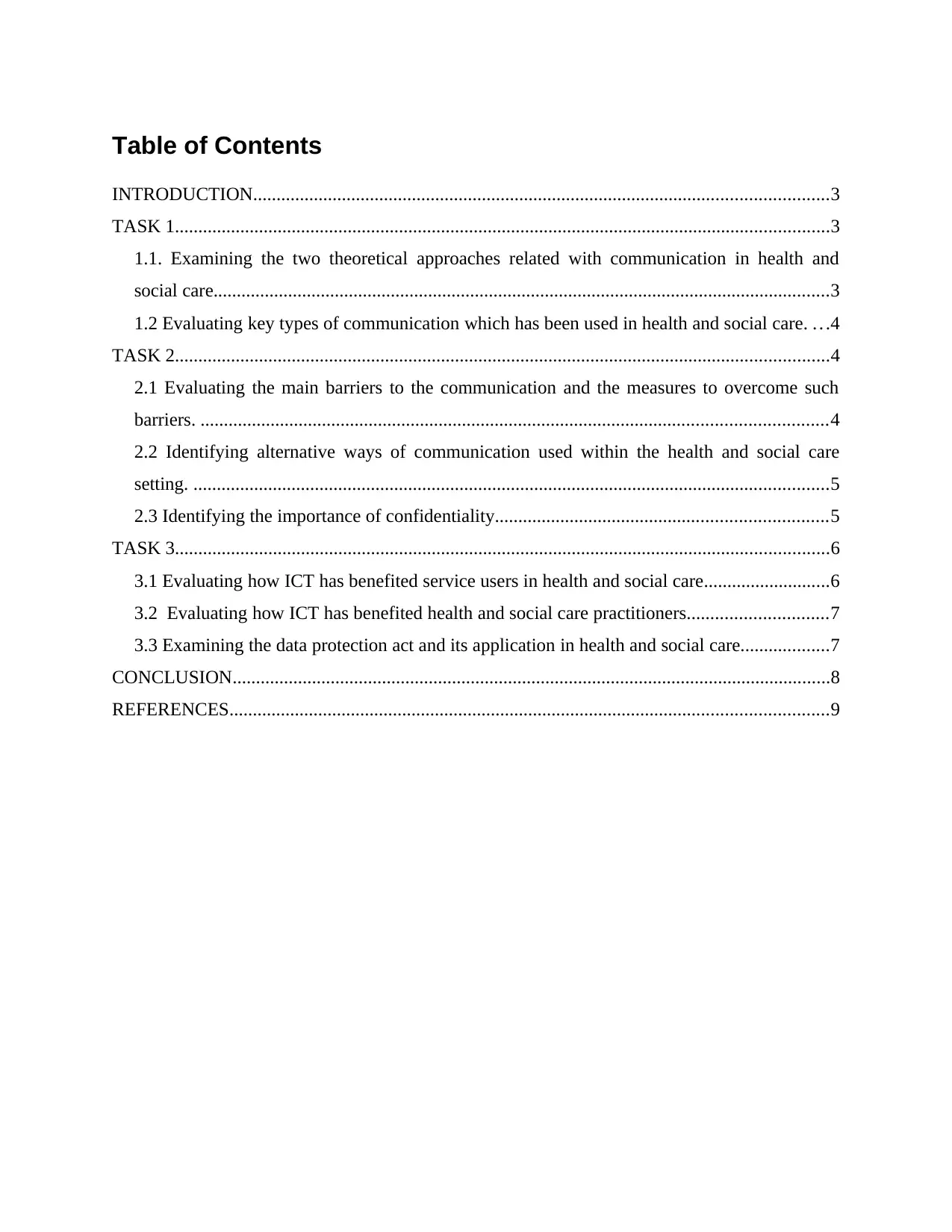
Table of Contents
INTRODUCTION...........................................................................................................................3
TASK 1............................................................................................................................................3
1.1. Examining the two theoretical approaches related with communication in health and
social care....................................................................................................................................3
1.2 Evaluating key types of communication which has been used in health and social care. .. .4
TASK 2............................................................................................................................................4
2.1 Evaluating the main barriers to the communication and the measures to overcome such
barriers. ......................................................................................................................................4
2.2 Identifying alternative ways of communication used within the health and social care
setting. ........................................................................................................................................5
2.3 Identifying the importance of confidentiality.......................................................................5
TASK 3............................................................................................................................................6
3.1 Evaluating how ICT has benefited service users in health and social care...........................6
3.2 Evaluating how ICT has benefited health and social care practitioners..............................7
3.3 Examining the data protection act and its application in health and social care...................7
CONCLUSION................................................................................................................................8
REFERENCES................................................................................................................................9
INTRODUCTION...........................................................................................................................3
TASK 1............................................................................................................................................3
1.1. Examining the two theoretical approaches related with communication in health and
social care....................................................................................................................................3
1.2 Evaluating key types of communication which has been used in health and social care. .. .4
TASK 2............................................................................................................................................4
2.1 Evaluating the main barriers to the communication and the measures to overcome such
barriers. ......................................................................................................................................4
2.2 Identifying alternative ways of communication used within the health and social care
setting. ........................................................................................................................................5
2.3 Identifying the importance of confidentiality.......................................................................5
TASK 3............................................................................................................................................6
3.1 Evaluating how ICT has benefited service users in health and social care...........................6
3.2 Evaluating how ICT has benefited health and social care practitioners..............................7
3.3 Examining the data protection act and its application in health and social care...................7
CONCLUSION................................................................................................................................8
REFERENCES................................................................................................................................9
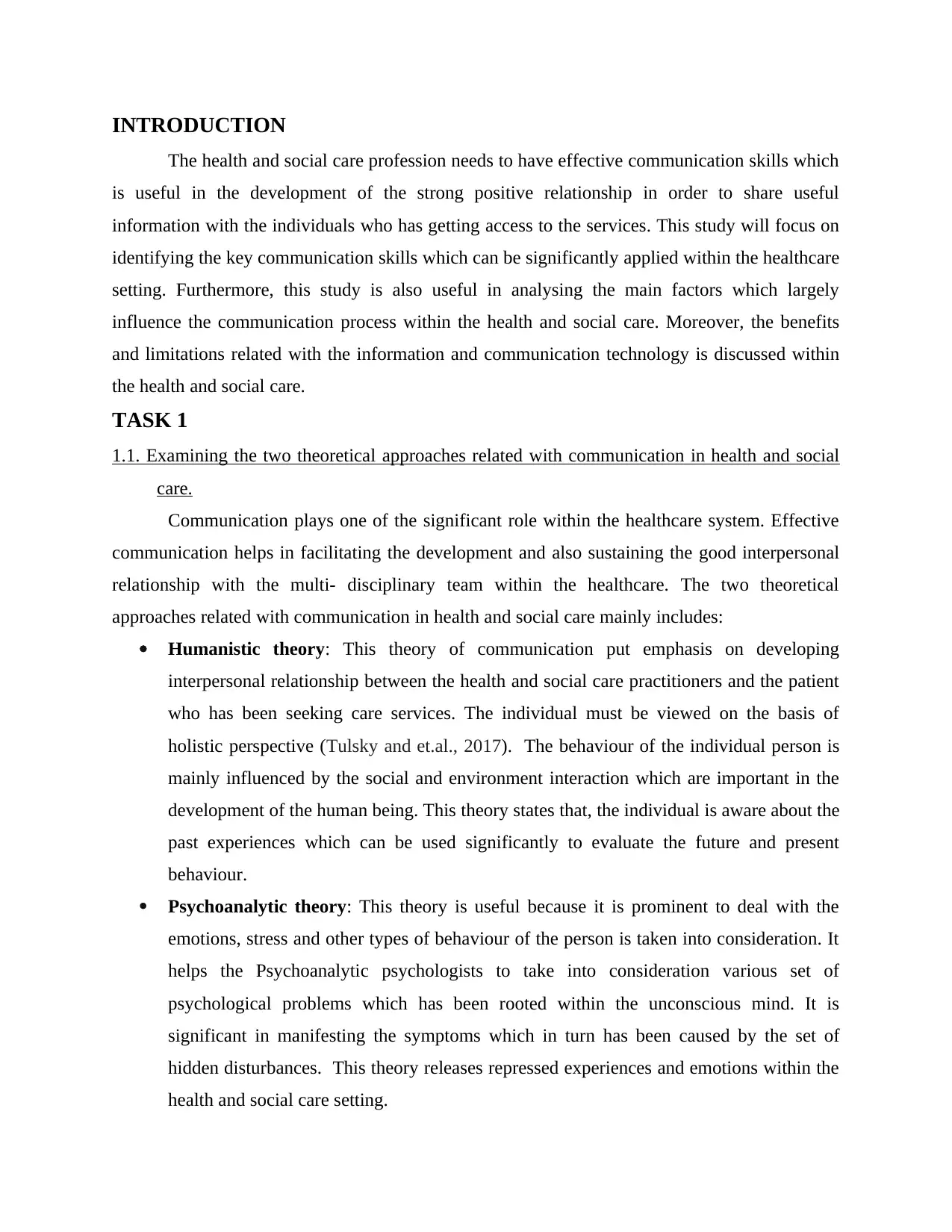
INTRODUCTION
The health and social care profession needs to have effective communication skills which
is useful in the development of the strong positive relationship in order to share useful
information with the individuals who has getting access to the services. This study will focus on
identifying the key communication skills which can be significantly applied within the healthcare
setting. Furthermore, this study is also useful in analysing the main factors which largely
influence the communication process within the health and social care. Moreover, the benefits
and limitations related with the information and communication technology is discussed within
the health and social care.
TASK 1
1.1. Examining the two theoretical approaches related with communication in health and social
care.
Communication plays one of the significant role within the healthcare system. Effective
communication helps in facilitating the development and also sustaining the good interpersonal
relationship with the multi- disciplinary team within the healthcare. The two theoretical
approaches related with communication in health and social care mainly includes:
Humanistic theory: This theory of communication put emphasis on developing
interpersonal relationship between the health and social care practitioners and the patient
who has been seeking care services. The individual must be viewed on the basis of
holistic perspective (Tulsky and et.al., 2017). The behaviour of the individual person is
mainly influenced by the social and environment interaction which are important in the
development of the human being. This theory states that, the individual is aware about the
past experiences which can be used significantly to evaluate the future and present
behaviour.
Psychoanalytic theory: This theory is useful because it is prominent to deal with the
emotions, stress and other types of behaviour of the person is taken into consideration. It
helps the Psychoanalytic psychologists to take into consideration various set of
psychological problems which has been rooted within the unconscious mind. It is
significant in manifesting the symptoms which in turn has been caused by the set of
hidden disturbances. This theory releases repressed experiences and emotions within the
health and social care setting.
The health and social care profession needs to have effective communication skills which
is useful in the development of the strong positive relationship in order to share useful
information with the individuals who has getting access to the services. This study will focus on
identifying the key communication skills which can be significantly applied within the healthcare
setting. Furthermore, this study is also useful in analysing the main factors which largely
influence the communication process within the health and social care. Moreover, the benefits
and limitations related with the information and communication technology is discussed within
the health and social care.
TASK 1
1.1. Examining the two theoretical approaches related with communication in health and social
care.
Communication plays one of the significant role within the healthcare system. Effective
communication helps in facilitating the development and also sustaining the good interpersonal
relationship with the multi- disciplinary team within the healthcare. The two theoretical
approaches related with communication in health and social care mainly includes:
Humanistic theory: This theory of communication put emphasis on developing
interpersonal relationship between the health and social care practitioners and the patient
who has been seeking care services. The individual must be viewed on the basis of
holistic perspective (Tulsky and et.al., 2017). The behaviour of the individual person is
mainly influenced by the social and environment interaction which are important in the
development of the human being. This theory states that, the individual is aware about the
past experiences which can be used significantly to evaluate the future and present
behaviour.
Psychoanalytic theory: This theory is useful because it is prominent to deal with the
emotions, stress and other types of behaviour of the person is taken into consideration. It
helps the Psychoanalytic psychologists to take into consideration various set of
psychological problems which has been rooted within the unconscious mind. It is
significant in manifesting the symptoms which in turn has been caused by the set of
hidden disturbances. This theory releases repressed experiences and emotions within the
health and social care setting.
⊘ This is a preview!⊘
Do you want full access?
Subscribe today to unlock all pages.

Trusted by 1+ million students worldwide
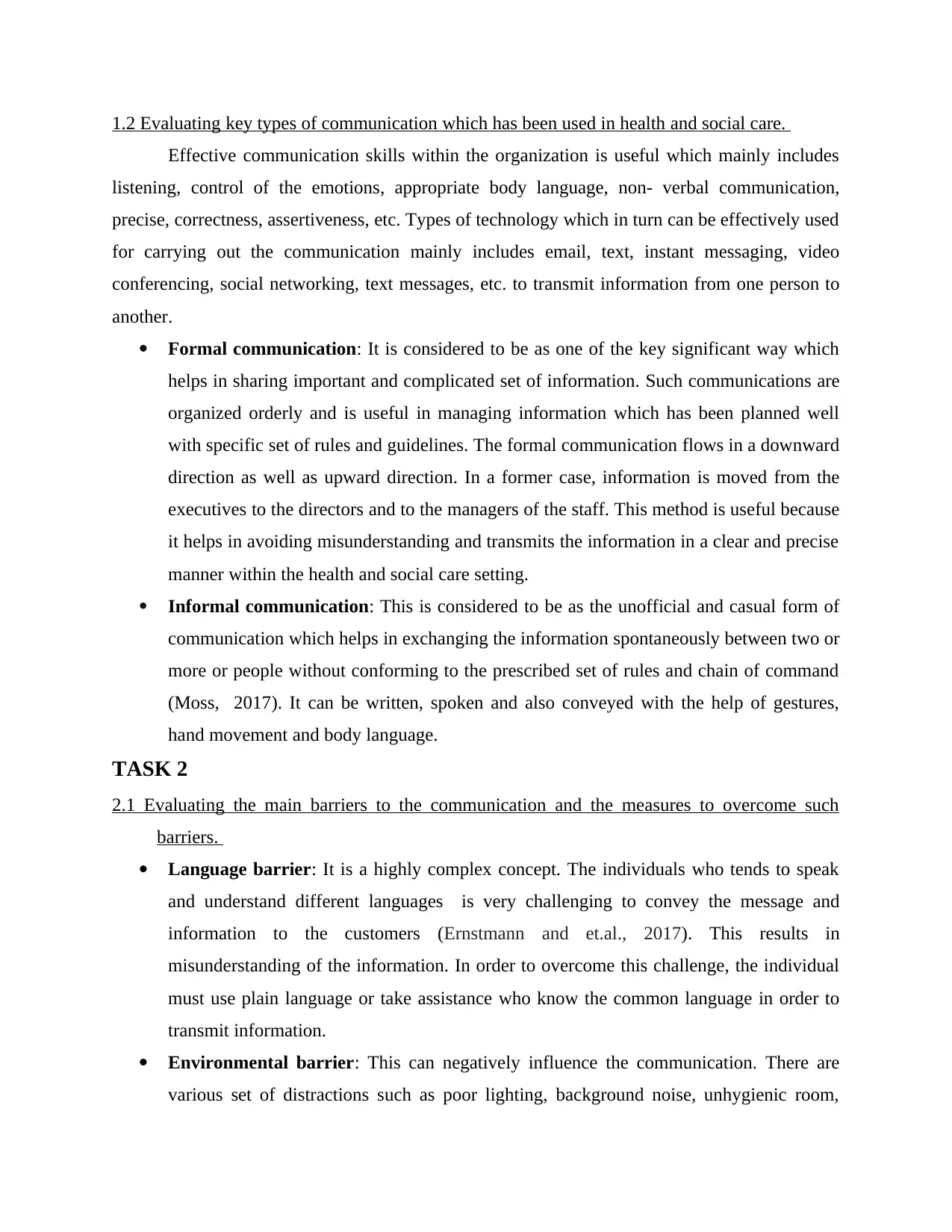
1.2 Evaluating key types of communication which has been used in health and social care.
Effective communication skills within the organization is useful which mainly includes
listening, control of the emotions, appropriate body language, non- verbal communication,
precise, correctness, assertiveness, etc. Types of technology which in turn can be effectively used
for carrying out the communication mainly includes email, text, instant messaging, video
conferencing, social networking, text messages, etc. to transmit information from one person to
another.
Formal communication: It is considered to be as one of the key significant way which
helps in sharing important and complicated set of information. Such communications are
organized orderly and is useful in managing information which has been planned well
with specific set of rules and guidelines. The formal communication flows in a downward
direction as well as upward direction. In a former case, information is moved from the
executives to the directors and to the managers of the staff. This method is useful because
it helps in avoiding misunderstanding and transmits the information in a clear and precise
manner within the health and social care setting.
Informal communication: This is considered to be as the unofficial and casual form of
communication which helps in exchanging the information spontaneously between two or
more or people without conforming to the prescribed set of rules and chain of command
(Moss, 2017). It can be written, spoken and also conveyed with the help of gestures,
hand movement and body language.
TASK 2
2.1 Evaluating the main barriers to the communication and the measures to overcome such
barriers.
Language barrier: It is a highly complex concept. The individuals who tends to speak
and understand different languages is very challenging to convey the message and
information to the customers (Ernstmann and et.al., 2017). This results in
misunderstanding of the information. In order to overcome this challenge, the individual
must use plain language or take assistance who know the common language in order to
transmit information.
Environmental barrier: This can negatively influence the communication. There are
various set of distractions such as poor lighting, background noise, unhygienic room,
Effective communication skills within the organization is useful which mainly includes
listening, control of the emotions, appropriate body language, non- verbal communication,
precise, correctness, assertiveness, etc. Types of technology which in turn can be effectively used
for carrying out the communication mainly includes email, text, instant messaging, video
conferencing, social networking, text messages, etc. to transmit information from one person to
another.
Formal communication: It is considered to be as one of the key significant way which
helps in sharing important and complicated set of information. Such communications are
organized orderly and is useful in managing information which has been planned well
with specific set of rules and guidelines. The formal communication flows in a downward
direction as well as upward direction. In a former case, information is moved from the
executives to the directors and to the managers of the staff. This method is useful because
it helps in avoiding misunderstanding and transmits the information in a clear and precise
manner within the health and social care setting.
Informal communication: This is considered to be as the unofficial and casual form of
communication which helps in exchanging the information spontaneously between two or
more or people without conforming to the prescribed set of rules and chain of command
(Moss, 2017). It can be written, spoken and also conveyed with the help of gestures,
hand movement and body language.
TASK 2
2.1 Evaluating the main barriers to the communication and the measures to overcome such
barriers.
Language barrier: It is a highly complex concept. The individuals who tends to speak
and understand different languages is very challenging to convey the message and
information to the customers (Ernstmann and et.al., 2017). This results in
misunderstanding of the information. In order to overcome this challenge, the individual
must use plain language or take assistance who know the common language in order to
transmit information.
Environmental barrier: This can negatively influence the communication. There are
various set of distractions such as poor lighting, background noise, unhygienic room,
Paraphrase This Document
Need a fresh take? Get an instant paraphrase of this document with our AI Paraphraser
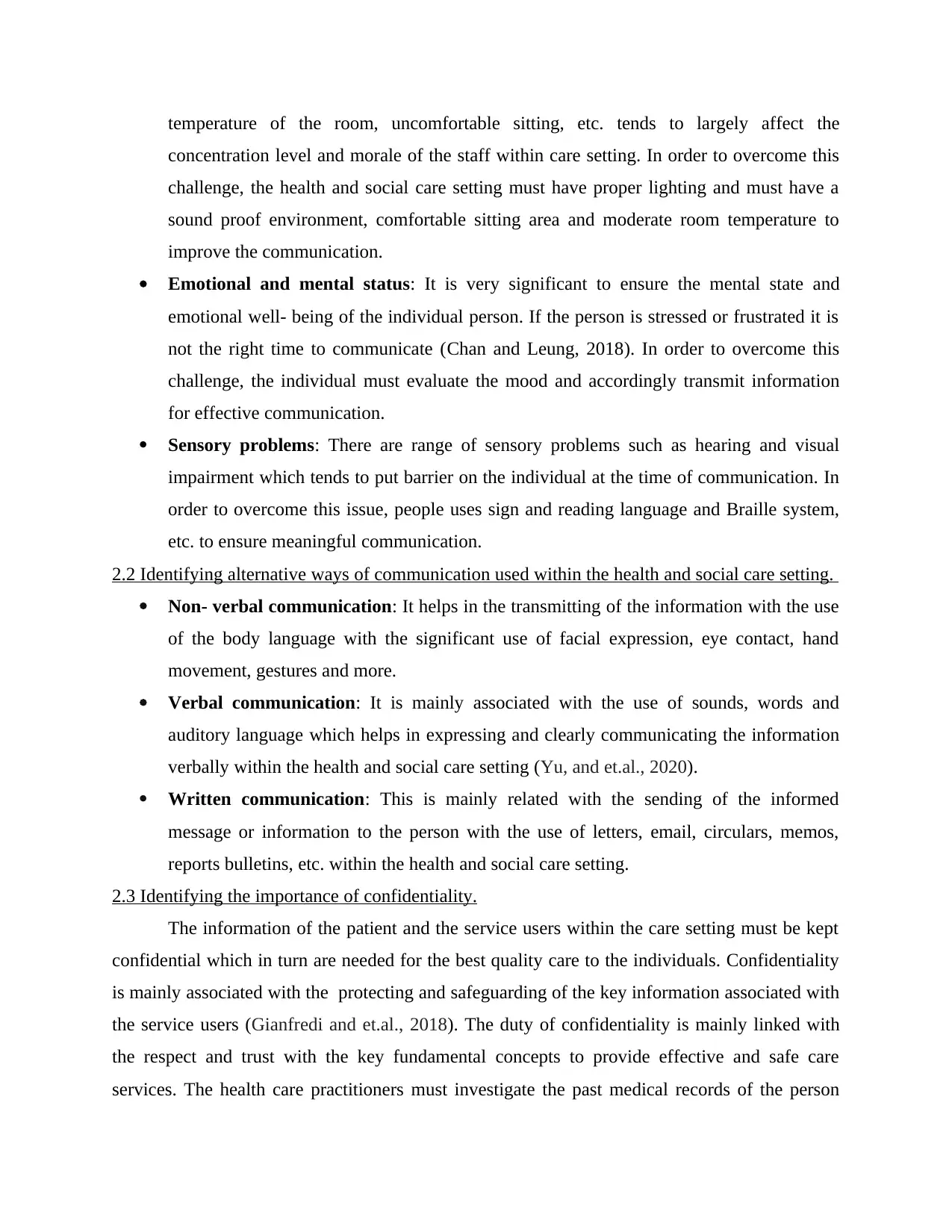
temperature of the room, uncomfortable sitting, etc. tends to largely affect the
concentration level and morale of the staff within care setting. In order to overcome this
challenge, the health and social care setting must have proper lighting and must have a
sound proof environment, comfortable sitting area and moderate room temperature to
improve the communication.
Emotional and mental status: It is very significant to ensure the mental state and
emotional well- being of the individual person. If the person is stressed or frustrated it is
not the right time to communicate (Chan and Leung, 2018). In order to overcome this
challenge, the individual must evaluate the mood and accordingly transmit information
for effective communication.
Sensory problems: There are range of sensory problems such as hearing and visual
impairment which tends to put barrier on the individual at the time of communication. In
order to overcome this issue, people uses sign and reading language and Braille system,
etc. to ensure meaningful communication.
2.2 Identifying alternative ways of communication used within the health and social care setting.
Non- verbal communication: It helps in the transmitting of the information with the use
of the body language with the significant use of facial expression, eye contact, hand
movement, gestures and more.
Verbal communication: It is mainly associated with the use of sounds, words and
auditory language which helps in expressing and clearly communicating the information
verbally within the health and social care setting (Yu, and et.al., 2020).
Written communication: This is mainly related with the sending of the informed
message or information to the person with the use of letters, email, circulars, memos,
reports bulletins, etc. within the health and social care setting.
2.3 Identifying the importance of confidentiality.
The information of the patient and the service users within the care setting must be kept
confidential which in turn are needed for the best quality care to the individuals. Confidentiality
is mainly associated with the protecting and safeguarding of the key information associated with
the service users (Gianfredi and et.al., 2018). The duty of confidentiality is mainly linked with
the respect and trust with the key fundamental concepts to provide effective and safe care
services. The health care practitioners must investigate the past medical records of the person
concentration level and morale of the staff within care setting. In order to overcome this
challenge, the health and social care setting must have proper lighting and must have a
sound proof environment, comfortable sitting area and moderate room temperature to
improve the communication.
Emotional and mental status: It is very significant to ensure the mental state and
emotional well- being of the individual person. If the person is stressed or frustrated it is
not the right time to communicate (Chan and Leung, 2018). In order to overcome this
challenge, the individual must evaluate the mood and accordingly transmit information
for effective communication.
Sensory problems: There are range of sensory problems such as hearing and visual
impairment which tends to put barrier on the individual at the time of communication. In
order to overcome this issue, people uses sign and reading language and Braille system,
etc. to ensure meaningful communication.
2.2 Identifying alternative ways of communication used within the health and social care setting.
Non- verbal communication: It helps in the transmitting of the information with the use
of the body language with the significant use of facial expression, eye contact, hand
movement, gestures and more.
Verbal communication: It is mainly associated with the use of sounds, words and
auditory language which helps in expressing and clearly communicating the information
verbally within the health and social care setting (Yu, and et.al., 2020).
Written communication: This is mainly related with the sending of the informed
message or information to the person with the use of letters, email, circulars, memos,
reports bulletins, etc. within the health and social care setting.
2.3 Identifying the importance of confidentiality.
The information of the patient and the service users within the care setting must be kept
confidential which in turn are needed for the best quality care to the individuals. Confidentiality
is mainly associated with the protecting and safeguarding of the key information associated with
the service users (Gianfredi and et.al., 2018). The duty of confidentiality is mainly linked with
the respect and trust with the key fundamental concepts to provide effective and safe care
services. The health care practitioners must investigate the past medical records of the person
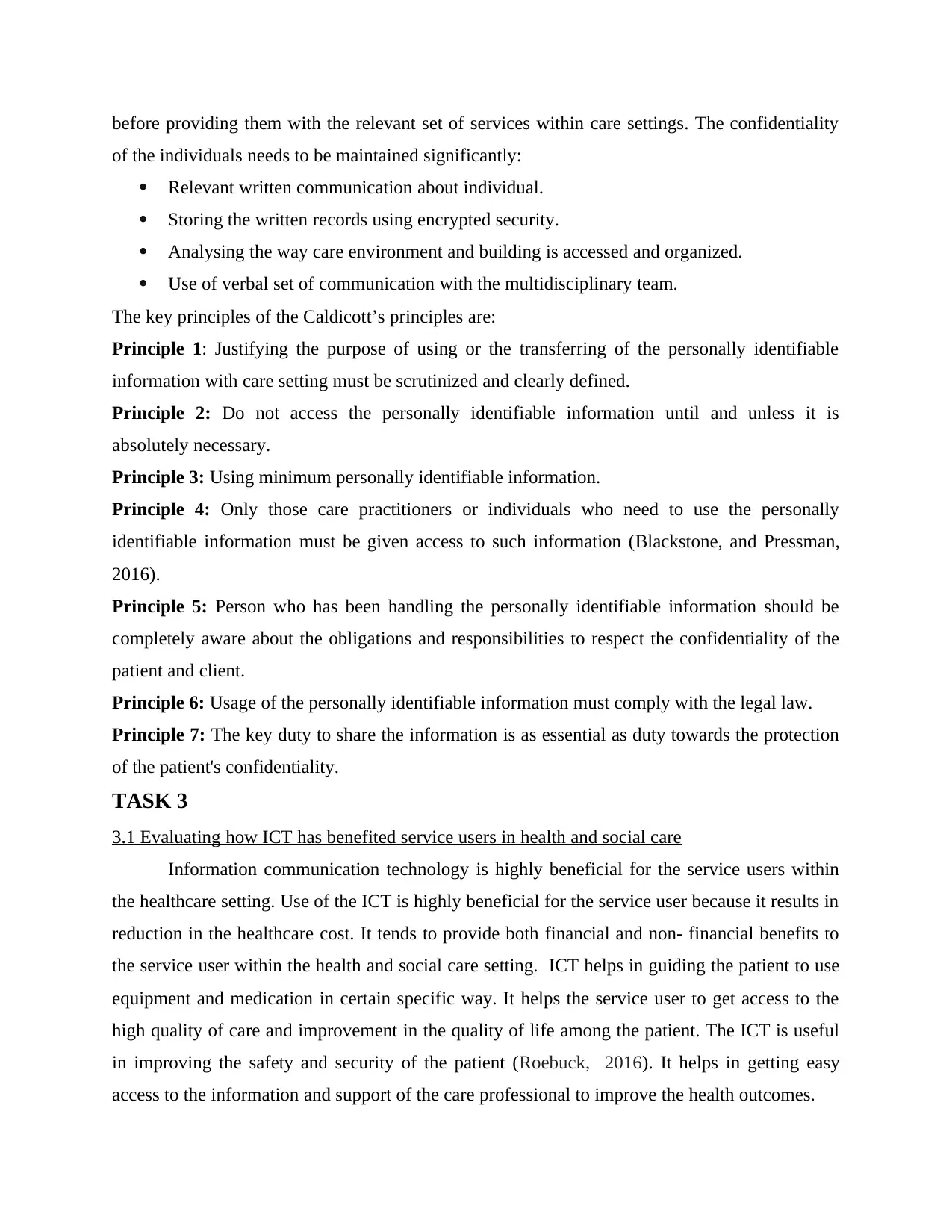
before providing them with the relevant set of services within care settings. The confidentiality
of the individuals needs to be maintained significantly:
Relevant written communication about individual.
Storing the written records using encrypted security.
Analysing the way care environment and building is accessed and organized.
Use of verbal set of communication with the multidisciplinary team.
The key principles of the Caldicott’s principles are:
Principle 1: Justifying the purpose of using or the transferring of the personally identifiable
information with care setting must be scrutinized and clearly defined.
Principle 2: Do not access the personally identifiable information until and unless it is
absolutely necessary.
Principle 3: Using minimum personally identifiable information.
Principle 4: Only those care practitioners or individuals who need to use the personally
identifiable information must be given access to such information (Blackstone, and Pressman,
2016).
Principle 5: Person who has been handling the personally identifiable information should be
completely aware about the obligations and responsibilities to respect the confidentiality of the
patient and client.
Principle 6: Usage of the personally identifiable information must comply with the legal law.
Principle 7: The key duty to share the information is as essential as duty towards the protection
of the patient's confidentiality.
TASK 3
3.1 Evaluating how ICT has benefited service users in health and social care
Information communication technology is highly beneficial for the service users within
the healthcare setting. Use of the ICT is highly beneficial for the service user because it results in
reduction in the healthcare cost. It tends to provide both financial and non- financial benefits to
the service user within the health and social care setting. ICT helps in guiding the patient to use
equipment and medication in certain specific way. It helps the service user to get access to the
high quality of care and improvement in the quality of life among the patient. The ICT is useful
in improving the safety and security of the patient (Roebuck, 2016). It helps in getting easy
access to the information and support of the care professional to improve the health outcomes.
of the individuals needs to be maintained significantly:
Relevant written communication about individual.
Storing the written records using encrypted security.
Analysing the way care environment and building is accessed and organized.
Use of verbal set of communication with the multidisciplinary team.
The key principles of the Caldicott’s principles are:
Principle 1: Justifying the purpose of using or the transferring of the personally identifiable
information with care setting must be scrutinized and clearly defined.
Principle 2: Do not access the personally identifiable information until and unless it is
absolutely necessary.
Principle 3: Using minimum personally identifiable information.
Principle 4: Only those care practitioners or individuals who need to use the personally
identifiable information must be given access to such information (Blackstone, and Pressman,
2016).
Principle 5: Person who has been handling the personally identifiable information should be
completely aware about the obligations and responsibilities to respect the confidentiality of the
patient and client.
Principle 6: Usage of the personally identifiable information must comply with the legal law.
Principle 7: The key duty to share the information is as essential as duty towards the protection
of the patient's confidentiality.
TASK 3
3.1 Evaluating how ICT has benefited service users in health and social care
Information communication technology is highly beneficial for the service users within
the healthcare setting. Use of the ICT is highly beneficial for the service user because it results in
reduction in the healthcare cost. It tends to provide both financial and non- financial benefits to
the service user within the health and social care setting. ICT helps in guiding the patient to use
equipment and medication in certain specific way. It helps the service user to get access to the
high quality of care and improvement in the quality of life among the patient. The ICT is useful
in improving the safety and security of the patient (Roebuck, 2016). It helps in getting easy
access to the information and support of the care professional to improve the health outcomes.
⊘ This is a preview!⊘
Do you want full access?
Subscribe today to unlock all pages.

Trusted by 1+ million students worldwide
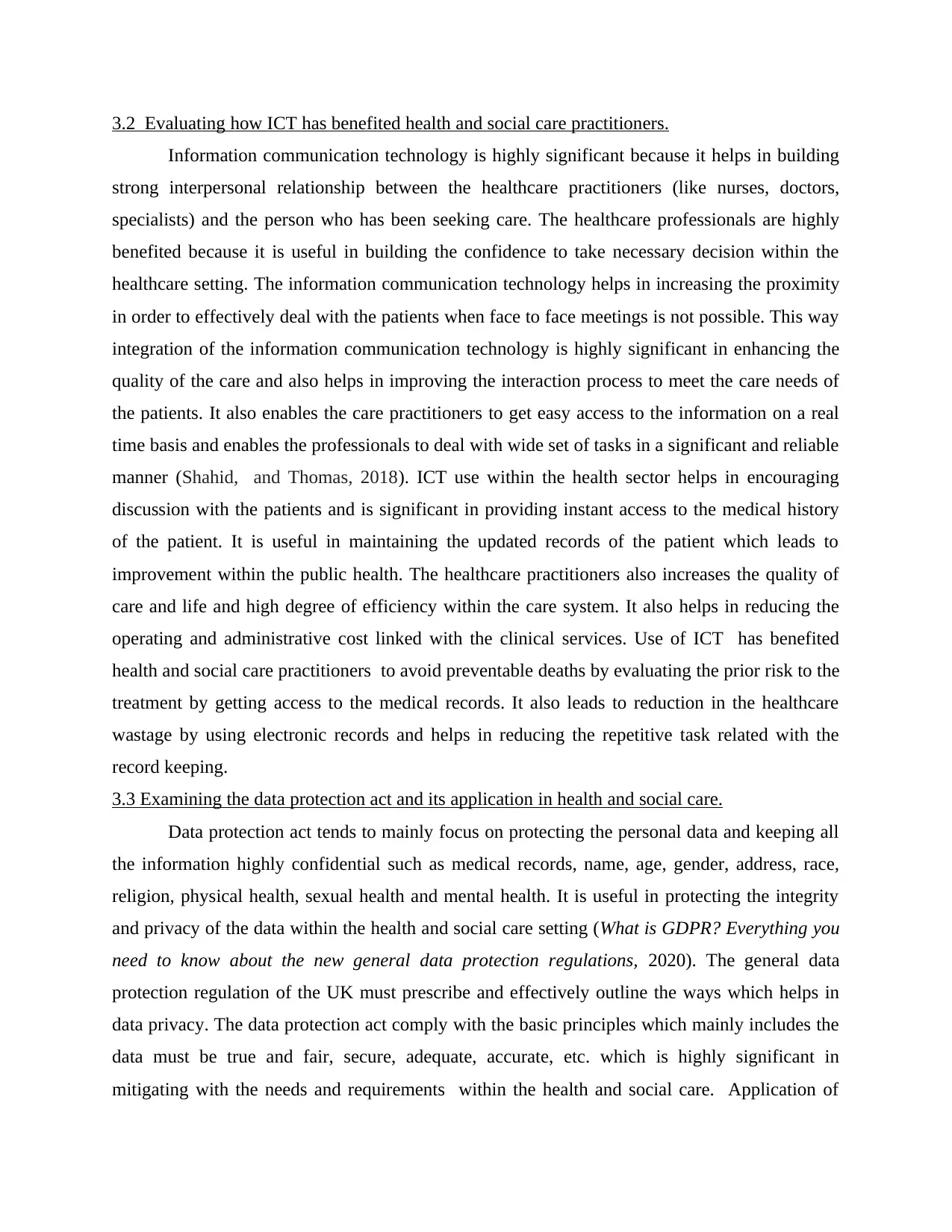
3.2 Evaluating how ICT has benefited health and social care practitioners.
Information communication technology is highly significant because it helps in building
strong interpersonal relationship between the healthcare practitioners (like nurses, doctors,
specialists) and the person who has been seeking care. The healthcare professionals are highly
benefited because it is useful in building the confidence to take necessary decision within the
healthcare setting. The information communication technology helps in increasing the proximity
in order to effectively deal with the patients when face to face meetings is not possible. This way
integration of the information communication technology is highly significant in enhancing the
quality of the care and also helps in improving the interaction process to meet the care needs of
the patients. It also enables the care practitioners to get easy access to the information on a real
time basis and enables the professionals to deal with wide set of tasks in a significant and reliable
manner (Shahid, and Thomas, 2018). ICT use within the health sector helps in encouraging
discussion with the patients and is significant in providing instant access to the medical history
of the patient. It is useful in maintaining the updated records of the patient which leads to
improvement within the public health. The healthcare practitioners also increases the quality of
care and life and high degree of efficiency within the care system. It also helps in reducing the
operating and administrative cost linked with the clinical services. Use of ICT has benefited
health and social care practitioners to avoid preventable deaths by evaluating the prior risk to the
treatment by getting access to the medical records. It also leads to reduction in the healthcare
wastage by using electronic records and helps in reducing the repetitive task related with the
record keeping.
3.3 Examining the data protection act and its application in health and social care.
Data protection act tends to mainly focus on protecting the personal data and keeping all
the information highly confidential such as medical records, name, age, gender, address, race,
religion, physical health, sexual health and mental health. It is useful in protecting the integrity
and privacy of the data within the health and social care setting (What is GDPR? Everything you
need to know about the new general data protection regulations, 2020). The general data
protection regulation of the UK must prescribe and effectively outline the ways which helps in
data privacy. The data protection act comply with the basic principles which mainly includes the
data must be true and fair, secure, adequate, accurate, etc. which is highly significant in
mitigating with the needs and requirements within the health and social care. Application of
Information communication technology is highly significant because it helps in building
strong interpersonal relationship between the healthcare practitioners (like nurses, doctors,
specialists) and the person who has been seeking care. The healthcare professionals are highly
benefited because it is useful in building the confidence to take necessary decision within the
healthcare setting. The information communication technology helps in increasing the proximity
in order to effectively deal with the patients when face to face meetings is not possible. This way
integration of the information communication technology is highly significant in enhancing the
quality of the care and also helps in improving the interaction process to meet the care needs of
the patients. It also enables the care practitioners to get easy access to the information on a real
time basis and enables the professionals to deal with wide set of tasks in a significant and reliable
manner (Shahid, and Thomas, 2018). ICT use within the health sector helps in encouraging
discussion with the patients and is significant in providing instant access to the medical history
of the patient. It is useful in maintaining the updated records of the patient which leads to
improvement within the public health. The healthcare practitioners also increases the quality of
care and life and high degree of efficiency within the care system. It also helps in reducing the
operating and administrative cost linked with the clinical services. Use of ICT has benefited
health and social care practitioners to avoid preventable deaths by evaluating the prior risk to the
treatment by getting access to the medical records. It also leads to reduction in the healthcare
wastage by using electronic records and helps in reducing the repetitive task related with the
record keeping.
3.3 Examining the data protection act and its application in health and social care.
Data protection act tends to mainly focus on protecting the personal data and keeping all
the information highly confidential such as medical records, name, age, gender, address, race,
religion, physical health, sexual health and mental health. It is useful in protecting the integrity
and privacy of the data within the health and social care setting (What is GDPR? Everything you
need to know about the new general data protection regulations, 2020). The general data
protection regulation of the UK must prescribe and effectively outline the ways which helps in
data privacy. The data protection act comply with the basic principles which mainly includes the
data must be true and fair, secure, adequate, accurate, etc. which is highly significant in
mitigating with the needs and requirements within the health and social care. Application of
Paraphrase This Document
Need a fresh take? Get an instant paraphrase of this document with our AI Paraphraser
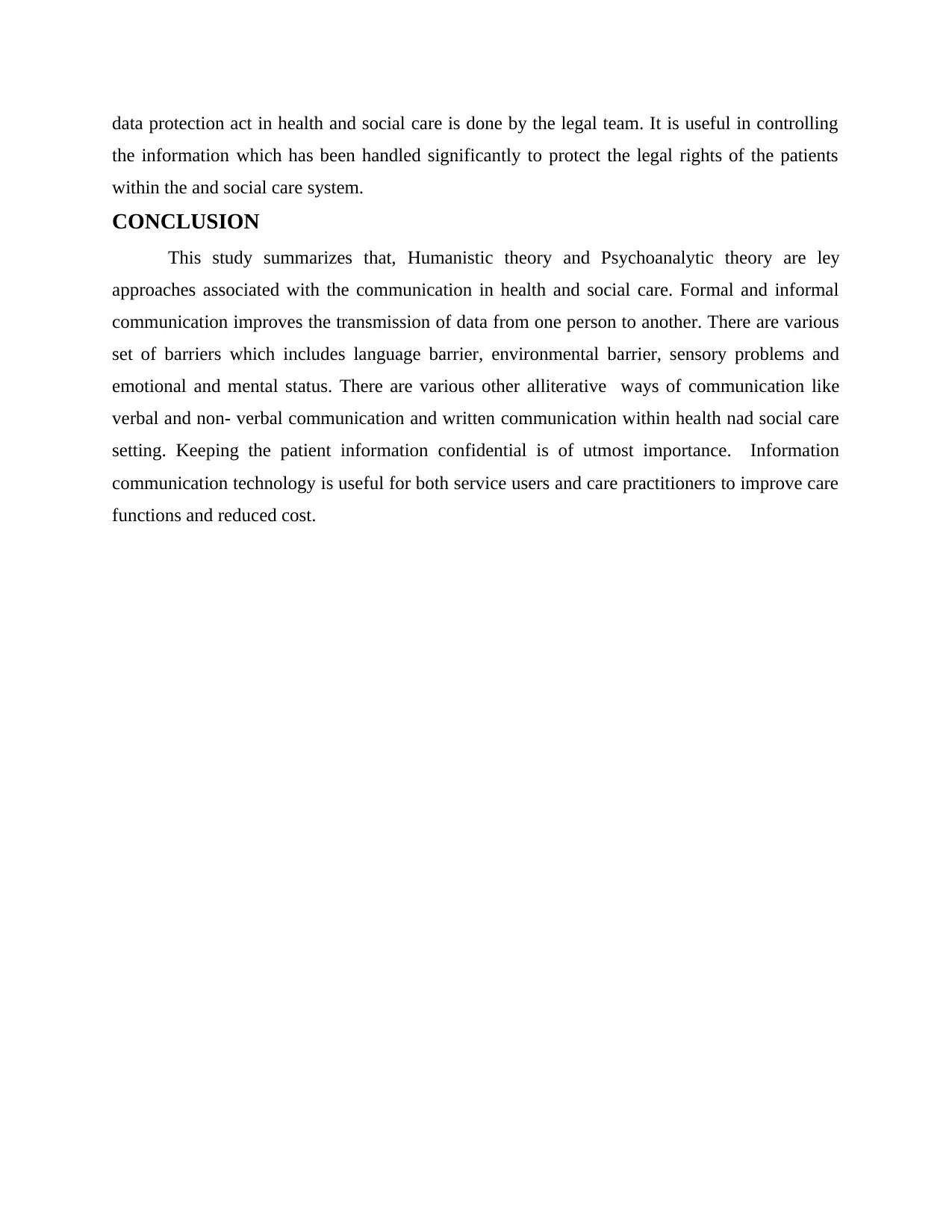
data protection act in health and social care is done by the legal team. It is useful in controlling
the information which has been handled significantly to protect the legal rights of the patients
within the and social care system.
CONCLUSION
This study summarizes that, Humanistic theory and Psychoanalytic theory are ley
approaches associated with the communication in health and social care. Formal and informal
communication improves the transmission of data from one person to another. There are various
set of barriers which includes language barrier, environmental barrier, sensory problems and
emotional and mental status. There are various other alliterative ways of communication like
verbal and non- verbal communication and written communication within health nad social care
setting. Keeping the patient information confidential is of utmost importance. Information
communication technology is useful for both service users and care practitioners to improve care
functions and reduced cost.
the information which has been handled significantly to protect the legal rights of the patients
within the and social care system.
CONCLUSION
This study summarizes that, Humanistic theory and Psychoanalytic theory are ley
approaches associated with the communication in health and social care. Formal and informal
communication improves the transmission of data from one person to another. There are various
set of barriers which includes language barrier, environmental barrier, sensory problems and
emotional and mental status. There are various other alliterative ways of communication like
verbal and non- verbal communication and written communication within health nad social care
setting. Keeping the patient information confidential is of utmost importance. Information
communication technology is useful for both service users and care practitioners to improve care
functions and reduced cost.

REFERENCES
Books and Journals
Tulsky, J.A and et.al., 2017. A research agenda for communication between health care
professionals and patients living with serious illness. JAMA internal medicine, 177(9),
pp.1361-1366.
Moss, B., 2017. Communication skills in health and social care. Sage.
Ernstmann, N. and et.al., 2017. Patient–physician communication and health‐related quality of
life of patients with localised prostate cancer undergoing radical prostatectomy–a
longitudinal multilevel analysis. BJU international, 119(3), pp.396-405.
Chan, W.S. and Leung, A.Y., 2018. Use of social network sites for communication among health
professionals: systematic review. Journal of medical Internet research, 20(3), p.e117.
Yu, M and et.al., 2020. Communication related health crisis on social media: a case of COVID-
19 outbreak. Current Issues in Tourism, pp.1-7.
Gianfredi, V and et.al., 2018. Communication in health. Recenti progressi in medicina, 109(7),
pp.374-383.
Blackstone, S.W. and Pressman, H., 2016. Patient communication in health care settings: New
opportunities for augmentative and alternative communication. Augmentative and
Alternative Communication, 32(1), pp.69-79.
Roebuck, A., 2016. Rethinking Communication in Health and Social Care. Macmillan
International Higher Education.
Shahid, S. and Thomas, S., 2018. Situation, Background, Assessment, Recommendation (SBAR)
communication tool for handoff in health care–a narrative review. Safety in Health, 4(1),
p.7.
Online
What is GDPR? Everything you need to know about the new general data protection regulations.
2020. [ONLINE]. Available through:<https://www.zdnet.com/article/gdpr-an-executive-guide-
to-what-you-need-to-know/>
Books and Journals
Tulsky, J.A and et.al., 2017. A research agenda for communication between health care
professionals and patients living with serious illness. JAMA internal medicine, 177(9),
pp.1361-1366.
Moss, B., 2017. Communication skills in health and social care. Sage.
Ernstmann, N. and et.al., 2017. Patient–physician communication and health‐related quality of
life of patients with localised prostate cancer undergoing radical prostatectomy–a
longitudinal multilevel analysis. BJU international, 119(3), pp.396-405.
Chan, W.S. and Leung, A.Y., 2018. Use of social network sites for communication among health
professionals: systematic review. Journal of medical Internet research, 20(3), p.e117.
Yu, M and et.al., 2020. Communication related health crisis on social media: a case of COVID-
19 outbreak. Current Issues in Tourism, pp.1-7.
Gianfredi, V and et.al., 2018. Communication in health. Recenti progressi in medicina, 109(7),
pp.374-383.
Blackstone, S.W. and Pressman, H., 2016. Patient communication in health care settings: New
opportunities for augmentative and alternative communication. Augmentative and
Alternative Communication, 32(1), pp.69-79.
Roebuck, A., 2016. Rethinking Communication in Health and Social Care. Macmillan
International Higher Education.
Shahid, S. and Thomas, S., 2018. Situation, Background, Assessment, Recommendation (SBAR)
communication tool for handoff in health care–a narrative review. Safety in Health, 4(1),
p.7.
Online
What is GDPR? Everything you need to know about the new general data protection regulations.
2020. [ONLINE]. Available through:<https://www.zdnet.com/article/gdpr-an-executive-guide-
to-what-you-need-to-know/>
⊘ This is a preview!⊘
Do you want full access?
Subscribe today to unlock all pages.

Trusted by 1+ million students worldwide
1 out of 9
Related Documents
Your All-in-One AI-Powered Toolkit for Academic Success.
+13062052269
info@desklib.com
Available 24*7 on WhatsApp / Email
![[object Object]](/_next/static/media/star-bottom.7253800d.svg)
Unlock your academic potential
Copyright © 2020–2025 A2Z Services. All Rights Reserved. Developed and managed by ZUCOL.




